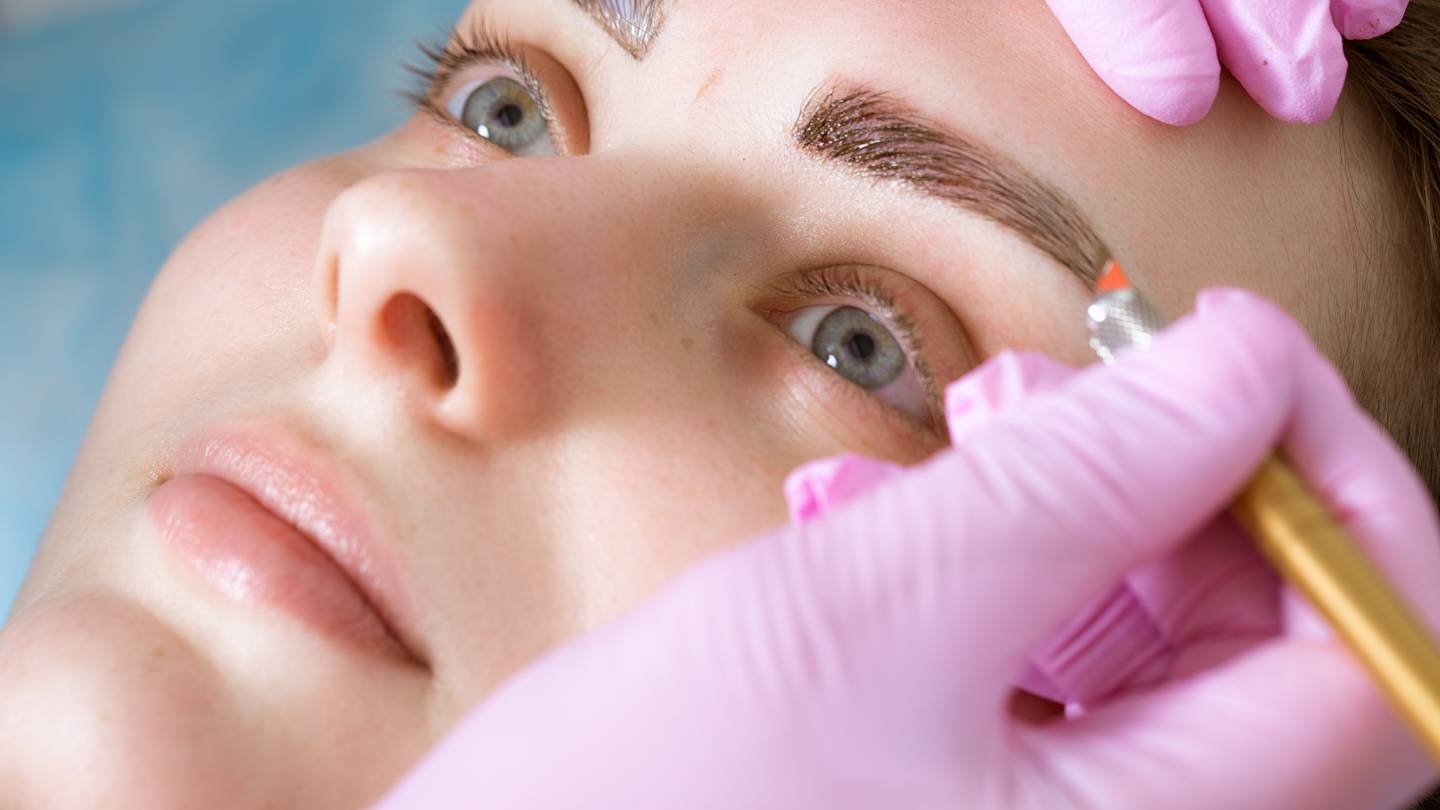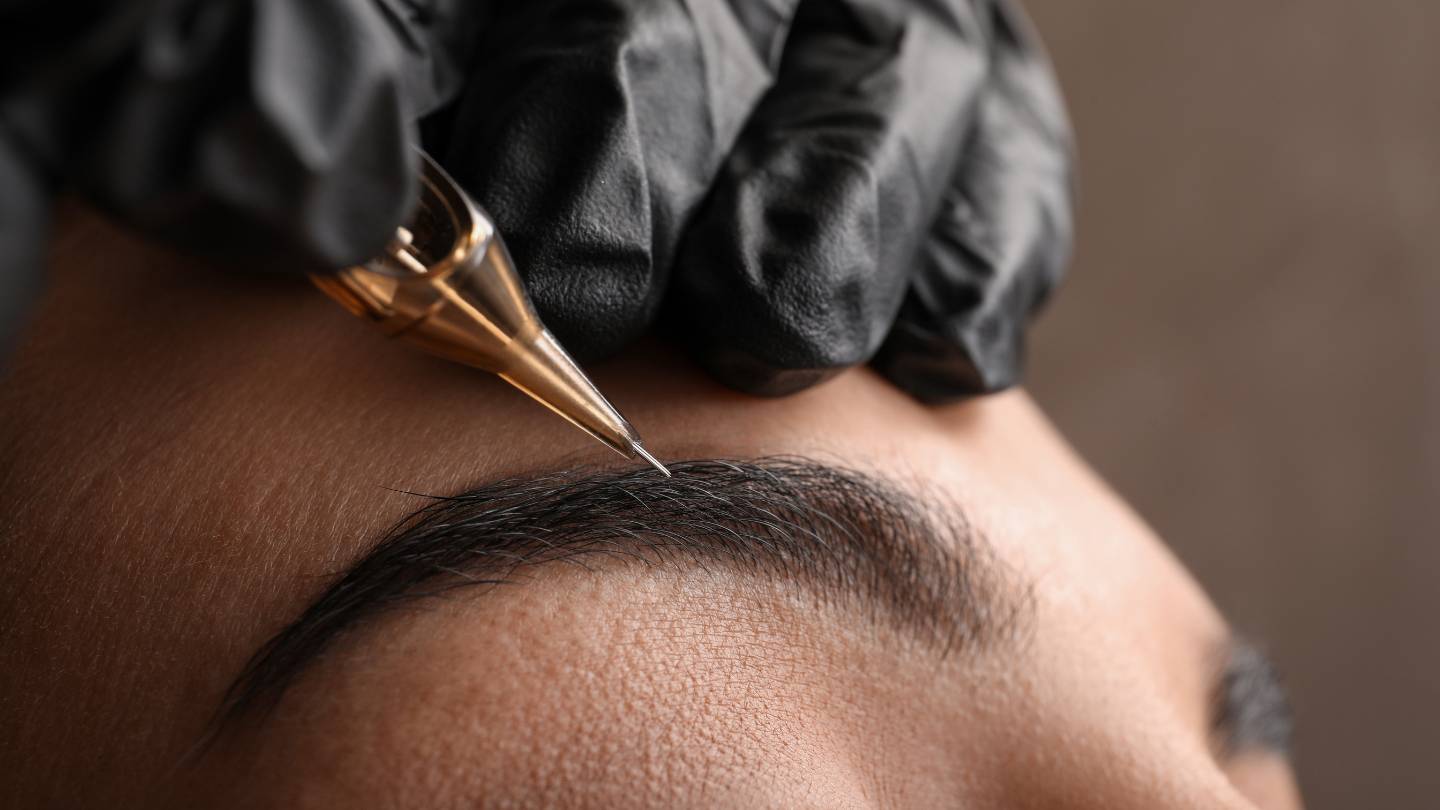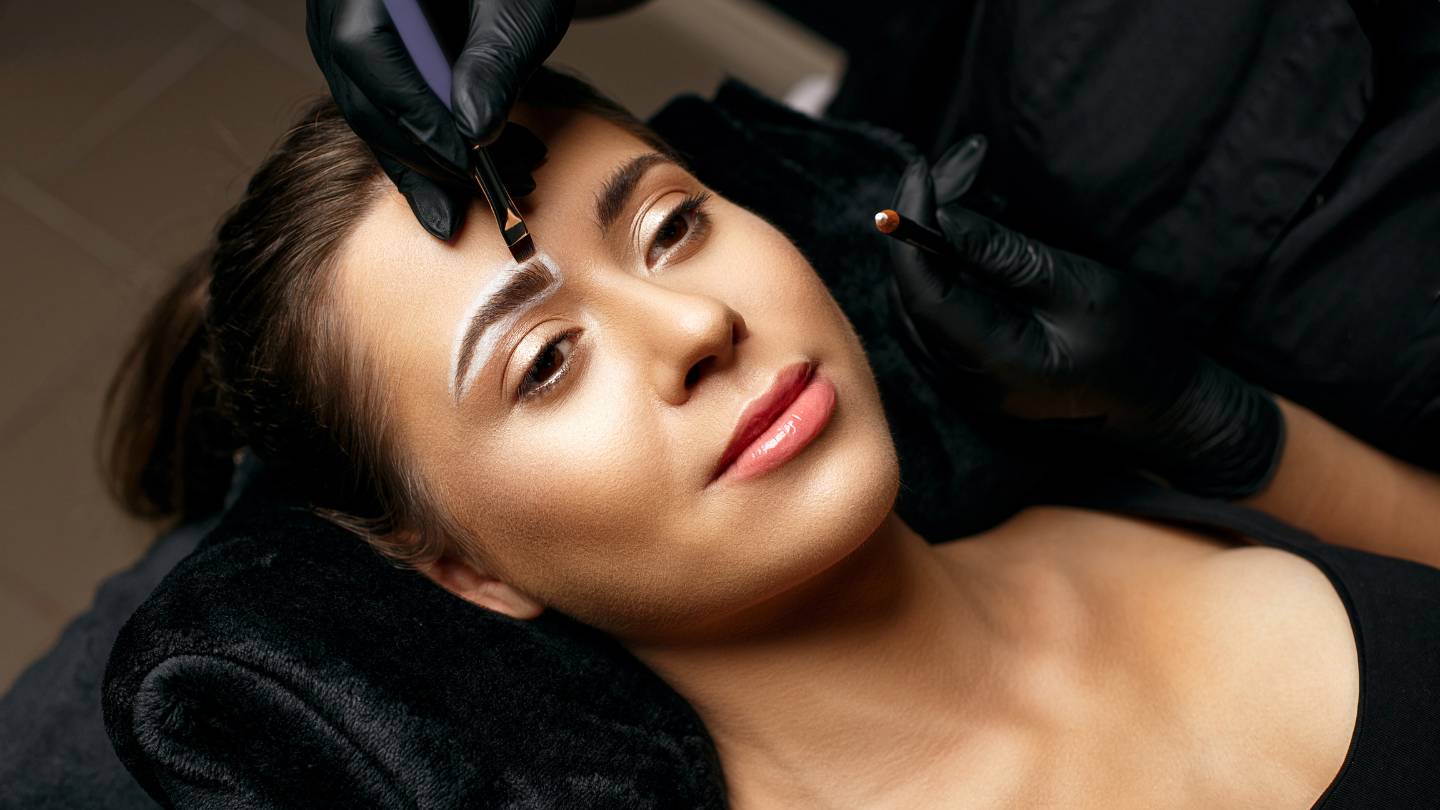Because microblading can cause excessive scarring, it may not be a good choice for people who are prone to keloids or hypertrophic scars. Because it can give you thicker, more defined eyebrows, microblading has become a major trend in the cosmetic industry.
However, it's important to note that this cosmetic procedure is not a panacea. Adverse reactions like eczema or psoriasis may occur in individuals with specific skin conditions. Further, proceed with caution if you tend to get scars easily.
Microblading has become a major trend in the cosmetic industry because it can give you thicker, more defined brows. However, it is important to note that this cosmetic procedure is not a cure-all. Individuals with specific skin conditions, such as eczema or psoriasis, may experience adverse reactions. Proceed with caution if you are prone to scarring.
What Is Microblading
Microblading, alternatively known as "feather touch" or "eyebrow embroidery," is a cosmetic process that aims to redefine and augment the eyebrows in a semipermanent semipermanent fashion.
In recent times, this groundbreaking methodology has amassed tremendous traction on account of its capacity to bestow upon users eyebrows that are inherently aesthetically pleasing and necessitate only modest daily upkeep.
What Disqualifies Someone From Microblading?
Pregnant Or Breastfeeding
Due to the fast changes happening in the body during pregnancy and breastfeeding, great care must be exercised. Here are some reasons why microblading isn't a good choice:
Possible Transfer Of Ink
Little is known about whether pigment particles put into the skin during microblading could be passed on to a developing baby or through breast milk. As a safety measure, the procedure is usually not done while pregnant or breastfeeding.
Hazard Of Complications
Because microblading damages tissue, the skin reacts by releasing inflammation-inducing immune cells. Despite being short-lived and harmless for the majority of people, these processes are closely monitored during pregnancy because they can cause the baby to have problems or even go into premature labour.
Elevated Oestrogen Concentrations
Microblading has been linked to a small rise in oestrogen levels in some people because it causes inflammation. Limiting triggers that aren't necessary is important for pregnant women, whose oestrogen production is already very high. Having a lot of oestrogen can make you more likely to get diseases like preeclampsia.
Discrepancy In Recovery
Changes in hormone levels during and after pregnancy can significantly affect the skin's ability to repair and regenerate. This means that the results of microbladed brows are less predictable and that problems like uneven pigment retention and prolonged redness are more likely to occur.
Keloid Scars
Not everyone is a good candidate for microblading; some people have a genetic tendency to develop keloid scars after skin wounds. When collagen grows excessively at the site of an injury as part of the body's normal healing process, a keloid scar forms. This results in elevated scars that spread beyond the original wound boundaries.
Hypertrophic scars, also known as raised scars, can form after microblading in patients more prone to keloid scarring. Thickened, raised scars and brow-distorting nodules can develop at the sites of ink deposition if the procedure's trauma triggers an overactive healing response.
Autoimmune Conditions
Several autoimmune diseases that weaken the immune system and make it harder to control inflammation can make the microblading procedure less effective:
Lupus And Rheumatoid Arthritis
In these diseases, antibodies mistakenly target healthy tissue, thinking it is an enemy invader. Injuries from microblading can set off an immune response, leading to autoantibody activity flare-ups and chronic inflammation for several weeks. This can result from prolonged redness, slowed healing, and altered pigment retention.
Multiple Sclerosis
MS occurs when the immune system mistakenly attacks nerve myelin. Microblading trauma may worsen abnormal immune activation, affecting brow sensation and ink deposit integration.
Bowel Inflammatory Disorder
A correlation exists between conditions characterised by persistent intestinal inflammation and an enhanced immune response across the entire body. By stimulating the immune system further, microblading may exacerbate inflammatory bowel disease symptoms and complicate the healing of the brow.
Skin Problems Such As Psoriasis
People with autoimmune skin conditions that have a skin barrier that doesn't work right and chronic inflammation are more likely to have reactions to the tissue trauma of microblading. Healing may take a long time, and the results are hard to predict.
These autoimmune diseases have one thing in common: microblading overstimulates the immune system and the body's inflammatory response. There is a higher probability of:
- Irregular or persistent inflammation affects outcomes.
- Symptoms that are already present can worsen, leading to a lag in recovery.
- The retention of pigment may be affected by hypersensitive or unpredictable wound reactions.
- The recipient's satisfaction with the results is distorted due to altered sensory experiences.
Blood-Thinning/Bleeding Disorders
To implant pigment, the microblading technique makes multiple tiny punctures in the skin. People with disorders that affect coagulation or who take drugs that thin the blood are more likely to experience complications like:
Prolonged Bruising
Thinner blood clots less easily, so microblading wounds take longer to heal. This can cause weeks-long bruising that distorts brows during healing.
Uncontrollable Haemorrhage
People with clotting issues run the risk of experiencing more severe bleeding while getting microbladed. Medical complications and unsatisfactory results are more likely to occur in cases of intraoperative bleeding that cannot be promptly stopped.
Slow Healing of Injuries
Changes to the body's coagulation process affect its capacity to mend small wounds and regenerate damaged tissue. The time it takes for brows to stabilise and recover after microblading is prolonged because of this.
Pigment Depletion
When wounds take longer to heal, and scabs take longer to develop, there's a higher chance that implanted ink could come loose or move up into the dermis too soon. Fading and unevenness may result from this.
Modern Aesthetic Procedures
If you have recently had cosmetic work done, you should wait until they are completely healed before thinking about microblading. When you do this, you make sure your skin is in great shape and ready for the microblading process. Before microblading, you may need to wait a while after the following treatments:
Injectable Fillers and Botox
Before getting microbladed, most people advise waiting two weeks after getting injectable fillers or Botox. It is important to wait for the skin to settle before injecting brows so the injections do not change their shape or position.
Botox injections to the forehead and brow muscles within two weeks can temporarily weaken or paralyse them, making microblading difficult. This mobility and control compromise often causes:
- Resulting in an uneven arch of the eyebrow.
- Angles of attack that are not natural cause the shape to be distorted.
- A generally more distorted, less exact shape for the brow.
Procedures Utilising Laser Light
Skin sensitivity or irritation is a possible side effect of laser hair removal, resurfacing, and tattoo removal. Microblading is best done after the skin has completely healed. Consult your dermatologist or aesthetician for advice on the best waiting time for your individual treatments.
Health Problems
- Patients suffering from autoimmune disorders like Sjogren's, Lupus, Cronh's, Rheumatoid Arthritis, and Von Willebrand's.
- People with eczema, rosacea, or psoriasis near the treated area may experience skin irritations.
- Individuals receiving chemotherapy.
- Epileptic Individuals.
- Those whose diabetes is not under control (they must have their doctor's permission).
Stop Retinol/Retin-A 1 Week Prior
Skin cell turnover and collagen production are accelerated by retinoid and retinol products, which help diminish the appearance of fine lines and wrinkles. On the other hand, they pose a risk to individuals undergoing microblading, as they can make skin extremely sensitive, reactive, and irritated in the days after application.
Hypersensitive or reactive skin during the procedure increases the likelihood of complications such as:
- Scarring from an injury that lasts for a long time and discolours the eyebrows as they heal.
- An inflammatory response that affects the retention of pigment.
- Additional pain while microblading is being done.
- The duration of results is affected by the rate at which wounds heal.
The effects of retinol usually peak three to five days after application, and then they gradually fade due to its metabolism. If you want your microblading procedure to go smoothly and produce the best possible results, you should wait at least a week after you've stopped using retinol-containing products on your skin.
Recently Took Accutane
Accutane (isotretinoin) is an effective medication for acne because it reduces sebum production by focusing on oil glands. On the other hand, Accutane affects the skin's ability to regenerate and heal, and these side effects can last up to a year after your last dose. Those who have used the medication in the last 12 months may show signs of:
- Skin becomes more sensitive.
- Changes in how wounds recover.
- The inflammation is not predictable.
- Skin regenerative capabilities affected by ink stabilisation are less effective.
After microblading, you run the risk of experiencing all of these possible side effects, which include:
- Prolonged inflammation and pain
- Result distortion
- Variegated retention of pigment
- Enhanced brow fade efficiency
Although microblading can be done after Accutane, waiting at least 12 months after your last dose is usually advised before proceeding. This gives the skin enough time to return to its normal functions and patterns of wound response.
Dry skin/sunburn
To heal properly after microblading, the skin must be in the best possible condition. People who are presently in possession of
- Active sunburn
- Skin that is red, irritated, or inflammatory
- A worsening of skin conditions
In the aftermath of the procedure's tissue trauma, they will most likely display a more severe and protracted wound response. Problems that frequently occur comprise:
- Prolonged redness and swelling that does not go away within the recommended healing time.
- Tissue ink stabilisation is affected by heightened immune activation.
- Changes in wound response that are difficult to anticipate and can impact the outcome.
- An extended period of recovery that causes brow distortion during critical stages of healing.
- Dissatisfaction with the results and the overall experience are negatively affected.
Irritations of the skin, such as sunburn or dermatitis, cause the body to release inflammatory chemicals. Microblading causes an overactive immune response, which can make the results more difficult than they need to be.
Ingredient Allergies
To ensure efficacy and comfort, the microblading procedure incorporates a range of components, which comprise:
- Lidocaine (numbing agent)
- Nickel (a component in some pigments)
- Epinephrine (controls bleeding)
However, the procedure may not work, or the patient may experience serious side effects if they have an allergy to any of the following:
- A lidocaine allergy can cause numbness failure.
- Nickel pigment allergies can cause hypersensitivity and irritation.
- Symptoms of an allergic reaction to epinephrine include hypertension and heart palpitations.
Due to the lack of alternatives and the inability of patch tests to predict complications, any ingredient allergy is considered a definitive contraindication to microblading.
Therefore, people who are allergic to lidocaine, nickel, or epinephrine should not get this procedure. They should look into other brow-shaping options that don't involve these ingredients directly touching the skin.
Arrogant Presumptions
Although microblading can improve the look of eyebrows, it's crucial to go into the procedure with reasonable expectations. Microblading isn't the way to go if you want drastic or flawless results you'll never achieve.
Remember that microblading is a semipermanent option that simulates the appearance of hair strokes in real life. It does not promise perfect or long-lasting results but can make a big difference. To get an accurate picture that considers your characteristics and preferences, it's best to consult with an expert.
Preteens and Teens
While there is no hard and fast rule about how old a person must be to get microblading done, it is usually best left to older teens and adults. Let your eyebrows grow and develop naturally as a teenager.
Being mentally and emotionally prepared is also essential before deciding to have any cosmetic procedure. Before thinking about microblading for their children, parents or guardians should weigh the pros and cons and talk to an expert.
Conclusion
Microblading, also known as "feather touch" or "eyebrow embroidery," is a cosmetic procedure that aims to redefine and augment eyebrows in a semipermanent semipermanent fashion. It has gained popularity due to its ability to give thicker, more defined eyebrows. However, it is not a cure-all for individuals with specific skin conditions, such as eczema or psoriasis, as it can cause excessive scarring.
Some disqualifications from microblading include pregnancy or breastfeeding, as the procedure can cause potential transfer of pigment particles, a risk of complications, elevated oestrogen concentrations, discrepancy in recovery, keloid scars, autoimmune conditions, skin problems like psoriasis, blood-thinning/bleeding disorders, and blood-thinning/bleeding disorders.
Pregnant or breastfeeding women should avoid microblading due to the fast changes occurring during these periods. The procedure can cause inflammation-inducing immune cells, leading to premature labor and potential complications.
Keloid scars can form after skin wounds, while hypertrophic scars can form in patients more prone to keloid scarring. Autoimmune conditions, such as Lupus and Rheumatoid Arthritis, multiple sclerosis, and bowel inflammation disorders, can also make the procedure less effective.
People with autoimmune skin conditions, such as psoriasis, are more likely to have reactions to the tissue trauma of microblading, which can lead to irregular or persistent inflammation, worsening symptoms, altered sensory experiences, and delayed healing. Blood-thinning/bleeding disorders, such as those with clotting issues or taking drugs that thin blood, can also lead to complications during microblading.
Microblading is a cosmetic procedure that involves removing hair from the eyebrows using a laser light. It is best to wait for the skin to heal completely before microblading, as it can cause issues such as uneven arch, distorted angles, and a more distorted shape. Patients with autoimmune disorders, eczema, rosacea, or psoriasis near the treated area may experience skin irritations.
Retinol and retinol-A products can accelerate skin cell turnover and collagen production, but they can also make skin extremely sensitive, reactive, and irritated. This can lead to complications such as scarring, inflammation, and additional pain during the procedure. The duration of results depends on the rate at which wounds heal.
After taking Accutane, waiting at least 12 months after the last dose is usually advised to allow the skin time to return to its normal functions and patterns of wound response. Dry skin or sunburn can also affect healing, and people with allergies to lidocaine, nickel, or epinephrine should not undergo microblading.
Microblading is a semipermanent option that simulates the appearance of hair strokes in real life, but it does not promise perfect or long-lasting results. It is best left to older teens and adults, as they can grow and develop naturally as teenagers. Parents or guardians should weigh the pros and cons and consult an expert before considering microblading for their children.
Content Summary
- Microblading is a major trend in the cosmetic industry, offering thicker, defined brows.
- The procedure is not a universal solution and may lead to adverse reactions in some individuals.
- Eczema or psoriasis sufferers may experience complications from microblading due to specific skin conditions.
- Caution is advised for those prone to scarring, as microblading can cause excessive scarring in some individuals.
- Microblading, also known as "feather touch" or "eyebrow embroidery," is a semipermanent cosmetic process.
- The procedure aims to redefine and enhance eyebrows, requiring only modest daily upkeep.
- Pregnant or breastfeeding individuals should avoid microblading due to potential complications.
- Little is known about the transfer of ink to a developing baby or through breast milk during pregnancy.
- Microblading may lead to elevated oestrogen levels, impacting pregnant women with already high oestrogen production.
- Hormonal changes during and after pregnancy can affect the predictability of microbladed brow results.
- Genetic tendencies to develop keloid scars make some individuals unsuitable candidates for microblading.
- Hypertrophic scars may form after microblading in those prone to keloid scarring.
- Autoimmune conditions like lupus and rheumatoid arthritis can lead to adverse reactions and altered pigment retention.
- Multiple sclerosis may affect brow sensation and ink deposit integration after microblading.
- Inflammatory bowel disorders can be exacerbated by microblading, complicating brow healing.
- People with autoimmune skin conditions like psoriasis may experience prolonged healing and unpredictable results.
- Microblading overstimulates the immune system, leading to irregular inflammation and worsened symptoms.
- Blood-thinning disorders can cause complications, including prolonged bruising and uncontrollable hemorrhage.
- Slow healing of injuries and pigment depletion may occur in individuals with blood-thinning disorders.
- Waiting for complete healing from recent cosmetic work, like injectable fillers or Botox, is crucial before microblading.
- Botox injections within two weeks of microblading can result in uneven brow arches and distorted shapes.
- Laser procedures can cause skin sensitivity, requiring healed skin before microblading for optimal results.
- Health problems, autoimmune disorders, and skin conditions may disqualify individuals from microblading.
- Individuals undergoing chemotherapy or with uncontrolled diabetes should seek medical permission before microblading.
- Discontinuing retinol/Retin-A a week before microblading prevents scarring and inflammatory responses.
- Recently taking Accutane increases the risk of prolonged inflammation and variegated pigment retention.
- Waiting at least 12 months after Accutane is advised for optimal skin recovery before microblading.
- Microblading on sunburned or irritated skin may lead to prolonged redness and swelling.
- Individuals with active sunburn or dermatitis may experience difficulties in the microblading healing process.
- Ingredient allergies to components like lidocaine, nickel, or epinephrine can lead to complications.
- Allergic reactions may include numbness failure, hypersensitivity, or increased heart rate.
- Ingredient allergies are definitive contraindications to microblading, necessitating alternative brow-shaping options.
- It's crucial to approach microblading with realistic expectations, as it is a semipermanent solution.
- Microblading offers a simulated appearance of hair strokes but does not guarantee perfect or long-lasting results.
- The procedure is not suitable for preteens and teens, and older individuals are generally better candidates.
- Age alone is not the only consideration; mental and emotional preparedness is essential for cosmetic procedures.
- Parents or guardians should weigh the pros and cons and consult experts before allowing children to undergo microblading.
Frequently Asked Questions
Microblading is a semi-permanent makeup technique used to enhance or reshape eyebrows. It involves using a handheld tool with tiny needles to implant pigment into the skin, creating hair-like strokes. While many people opt for microblading to achieve fuller or more defined eyebrows, it is not suitable for everyone.
Yes, individuals with certain medical conditions or histories may not be suitable candidates for microblading. Conditions such as keloid scarring, hemophilia, or diabetes can affect the healing process and may pose risks during the procedure. It's essential to consult with a healthcare professional and a qualified microblading artist before undergoing the treatment.
Absolutely. Individuals with sensitive skin or a history of allergies, especially to pigments or metals, should be cautious about getting microblading. Allergic reactions can occur, leading to discomfort, swelling, or other complications. A patch test is often recommended to check for any adverse reactions before proceeding with the full treatment.
While age is not necessarily a restriction, skin type and condition play crucial roles in determining suitability for microblading. Very young or mature skin may not retain the pigment as effectively, and oily or problematic skin types may experience less satisfactory results. It's essential to discuss individual circumstances with a microblading specialist to ensure realistic expectations and optimal outcomes.
Prior cosmetic procedures or tattoos in the eyebrow area can impact the microblading process. Existing tattoos may need to be lightened or removed before microblading can be performed. Additionally, scar tissue from previous treatments can affect the pigment's uptake and the overall appearance of the brows. A thorough consultation with an experienced microblading artist will help determine the best approach based on individual circumstances.



